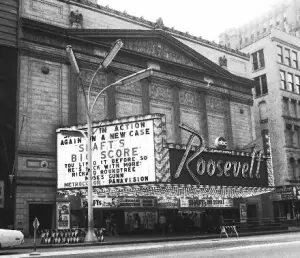110 North State Street
Built 1921
Architects: C. Howard Crane & H. Kenneth Franzheim
The Roosevelt Theater was one of about a dozen major movie houses that helped make the Loop a center of Midwest movie-going during the 1920s and 1930s. Within a block of the Roosevelt were the likes of the Chicago, the State-Lake, the Oriental, the Woods, and the United Artists theaters. Like its counterparts, the Roosevelt drew customers from near and far, including many out-of-towners who might be spending the weekend in the city, on stop-over from a cross-country train trip, or, for many men during the Second World War, taking in the sights on a weekend pass.
The Roosevelt opened for business in April of 1921 with Constance Talmadge in Lessons of Love. The theater was situated on the west side of State Street, about midway between Randolph and Washington. Located just one block to the north was the Chicago Theater, another prominent Loop movie palace, which opened just six months after the Roosevelt in late October of 1921. Directly across from theater’s lobby was the main entrance of the Marshall Field and Company department store.
Designed with a neo-classical façade, the Roosevelt seated just under 1,600. In 1923, the theater was purchased by the renowned Balaban and Katz theater circuit as the company expanded its dominance in the Chicago movie market.

Roosevelt Theater, ca. 1973
By the 1970s, the Roosevelt, like the other Loop movie palaces, began to languish from the combined effects of inadequate marketing, declining capital investment, substandard upkeep, the nationwide drop in movie attendance, and the increasing (and sometimes unfounded) undesirability of the Loop as an entertainment destination. Theater management, in order to keep revenues up, presented shows geared toward a primarily African- American audience.
Despite its difficulties, the Roosevelt continued to show a modest operating profit throughout the 1970s. Its closure in September of 1979 was due primarily to the forces of City Hall and real estate speculation.
The city had long sought to redevelop the one-block parcel of land on part of which the Roosevelt stood. Known by city planners as “Block 37,” it was hoped that construction of a large office building and retail center would help revitalize the Loop’s then-stagnant retail and theater trade. In the early 1980s, the Roosevelt, along with the United Artists Theater and virtually the rest of Block 37, was razed. Redevelopment of Block 37, however, faltered due in part to misguided city planning and the collapse of the real estate market later in the decade.
Sources: Ross Miller, Here’s the Deal: The Buying and Selling of a Great American City (New York: Knopf, 1996).
Image source: “Roosevelt Theater,” undated, Historic Architectural/Archeological Resources Geographic Information System, Illinois Historic Preservation Agency [http://gis.hpa.state.il.us/hargis/Reports/photos/Cook/66114.jpg] (7 November 2003), cropped.
